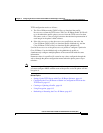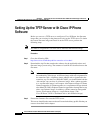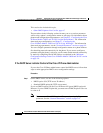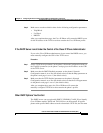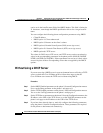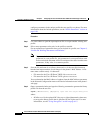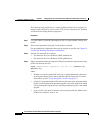
Chapter 6 Configuring the Cisco IP Phone Models 7905G and 7912G Using a TFTP Server
Configuring the Cisco IP Phone to Obtain its Configuration File from the TFTP Server
6-8
Cisco IP Phone Models 7905G and 7912G Administrator Guide (SIP)
OL-4277-01
can be set in the bootfile name field of the DHCP header. This field is limited to
31 characters, even though the DHCP specification allows for a longer bootfile
name.
You can configure the following phone configuration parameters using DHCP:
• Client IP address
• DHCP option 1: Client subnet mask
• DHCP option 3: Routers on the client’s subnet
• DHCP option 6: Domain Name System (DNS) server (up to two)
• DHCP option 42: Network Time Protocol (NTP) server (up to two)
• DHCP option 66: TFTP server
The values for DNS server, NTP server, and TFTP server can be overwritten by
values in the corresponding parameters in the phone profile (DNS1IP, DNS2IP,
NTPIP, AltNTPIP, and TftpURL). If these parameters are not set to 0, their values
are used in place of those corresponding values that are supplied by the DHCP
options.
Without Using a DHCP Server
If you are not using a DHCP server in your environment but are still using a TFTP
server to obtain the Cisco IP Phone profile, follow these steps so that the
Cisco IP Phone can contact the TFTP server without using DHCP:
Procedure
Step 1 Set the DHCP Enabled parameter on the phone’s Network Configuration menu to
No or set the Dhcp parameter on the phone’s web page to 0.
Step 2 Set the TFTP Enabled parameter on the phone’s Network Configuration menu to
Yes or set the UseTftp parameter on the phone’s web page to 1.
Step 3 Set the TFTP Server parameter on the phone’s Network Configuration menu to the
IP address or the URL of the TFTP server or set the TftpURL parameter on the
phone’s web page to the IP address or the URL of the TFTP server.
Step 4 If you have done already done so, statically configure the following parameters
using the phone’s Network Configuration menu. These parameters are required
for the phone to obtain network connectivity:






